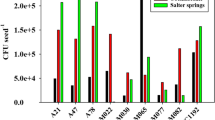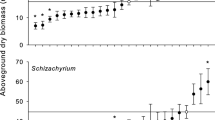Summary
TheRhizobium strains nodulating indigenous clover plants in Scottish hill pastures are predominantly of low effectiveness. The effectiveness of the population from each of the 48 sites examined was positively correlated with soil base status. The correlation was due to an increase in the proportion of the most effective class ofRhizobium, the less effective classes individually showing no relationship. The agronomic implications of the findings are discussed.
Similar content being viewed by others
References
Allen, O. N., Experiments in Soil Bacteriology. The Burgess Publishing Co., Minneapolis, Minn., U.S.A. (1949).
Andrew, C. S. and Norris, D. O., Comparative responses to calcium of five tropical and four temperate pasture legume species. Australian J. Agr. Research12, 40–55 (1961).
King, J., TheFestuca-Agrostis grassland complex in S.E. Scotland, I Variation in floristic composition. J. Ecol.50, 321–355 (1962).
King, J., Ecotypic differentiation inTrifolium repens. Plant and Soil18, 221–224 (1963).
Loneragan, J. F. and Dowling, E. J., The interaction of calcium and hydrogen ions in the nodulation of subterranean clover. Australian J. Agr. Research9, 464–472 (1958).
Mulder, E. G. and van Veen, W. L., Effect of pH and organic compounds on nitrogen fixation by red clover. Plant and Soil13, 91–113 (1960).
Norris, D. O., The role of calcium and magnesium in the nutrition ofRhizobium. Australian J. Agr. Research10, 651–697 (1959).
Parker, F. W., The determination of exchangeable hydrogen in soils. J. Am. Soc. Agron.21, 1030–1039 (1929).
Ratcliffe, D. A., The vegetation of the Carneddau, North Wales. I Grasslands, heaths and bogs. J. Ecol.47, 371–413 (1959).
Scott, R. O. and Ure, A. M., The determination of magnesium in solution by direct photometry. Analyst83, 561–570 (1958).
Thornton, H. G., The biological interactions ofRhizobium and its host legume. Antonie van Leeuwenhoek J. Microbiol. Serol.12, 85–96 (1947).
Ure, A. M., Spectrochemical applications of electronics in soil research. Brit. Commun. Electron.5, 846–849 (1958).
Vincent, J. M. and Waters, L. M., The root nodule bacteria as factors in clover establishment in the red basaltic soils of the Lismore district, N.S.W. II Survival and success of inocula in laboratory trials. Australian J. Agr. Research5, 61–89 (1954).
Williams, E. G. and Stewart, A. B., The colorimetric determination of readily soluble phosphate in soils. J. Soc. Chem. Ind. (London)60, 291–297 (1941).
Author information
Authors and Affiliations
Rights and permissions
About this article
Cite this article
Holding, A.J., King, J. The effectiveness of indigenous populations ofRhizobium trifolii in relation to soil factors. Plant Soil 18, 191–198 (1963). https://doi.org/10.1007/BF01347873
Received:
Issue Date:
DOI: https://doi.org/10.1007/BF01347873




